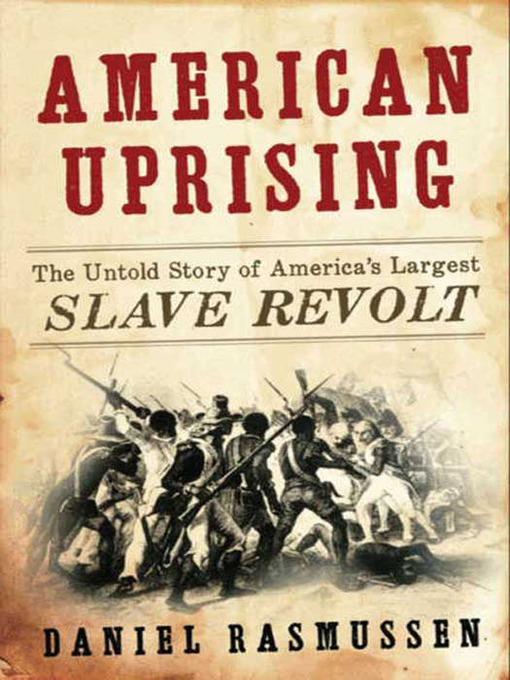
American Uprising
The Untold Story of America's Largest Slave Revolt
کتاب های مرتبط
- اطلاعات
- نقد و بررسی
- دیدگاه کاربران
نقد و بررسی

September 20, 2010
This study of a January 1811 slave uprising and march on New Orleans exhumes the deliberately obscured and "largest act of armed resistance against slavery in the history of the United States." Historian Rasmussen expands on scarce source material to provide a complex context for a revolt that dwarfed such better-known rebellions as Nat Turner's and Denmark Vesey's, a stealthily organized uprising of 500 armed slaves dressed in military uniforms marching on and trying to conquer New Orleans. The author ties together diverse political, economic, and cultural threads in describing the rise (and brutal suppression) of the "ethnically diverse, politically astute, and highly organized" army, and investigates why this "story more Braveheart than Beloved" was consigned to historical footnote. While the book's ambition occasionally exceeds its grasp, it vividly evokes the atmosphere of New Orleans of the early 19th century and how a recalcitrant, French-rooted Louisiana and some Spanish possessions in the Deep South were incorporated into the expanding American nation though brutal revenge justice and political pressures.

October 1, 2010
Rasmussen's auspicious debut (he graduated from Harvard in 2009) is the first book-length account of a large-scale, three-day slave revolt on the sugar plantations near New Orleans during the 1811 Carnival (Mardi Gras) season. The author argues that the slave-rebels, who had learned warfare tactics in their native Africa, were inspired by the successful Haitian revolution. These were not common criminals but political revolutionaries, contrary to the scant historical accounts of those eager to squash threats to the South's slave-reliant economy and deter its western expansion. Rasmussen, who boldly interjects opinions and conjecture into his narrative rather than allowing readers to come to their own conclusions, paints the slave-rebels, especially their leaders, as heroes and martyrs for the cause of liberty, and the slave owners and white politicians as ruthless, greedy, and inept. With few reliable primary sources at his disposal, he fills out his work with thorough historical context and vivid descriptions of the radically different daily lives of slaves and planters in antebellum Louisiana. VERDICT This is a welcome addition to popular history and an engaging read for anyone interested in this important chapter in the tragic story of American slavery. Scholars may have concerns about Rasmussen's rather heavy-handed characterizations.--Douglas King, Univ. of South Carolina Lib., Columbia
Copyright 2010 Library Journal, LLC Used with permission.

September 15, 2010
Recent Harvard grad Rasmussen uncovers the buried history of "the largest slave revolt in American history."
In 1811 outside of New Orleans, 500 enslaved men, some armed with guns, battled plantation owners. "While Nat Turner and John Brown have become household names," the author writes, "Kook and Quamana, Harry Kenner, and Charles Deslondes [the leaders of the revolt] have barely earned a footnote in American history." Rasmussen not only provides the backdrop against which the battle occurred, but explores the cultural roots of the conflict. Only eight years before, a successful slave rebellion had driven out the plantation owners, transforming the French sugar-producing colony Saint Domingue (now Haiti) into a free republic. That same year the United States had acquired the Louisiana Purchase and was still struggling to assimilate the disgruntled French sugar planters. In the early years of the occupation of the new territory, federal troops had to "confront the dangers of a sugar colony that relied on the forced labor of a slave population," while driving the Spanish out of Florida. The leaders of the 1811 revolt seized the opportunity of kickoff celebrations to the Carnival season for "a fight to the death against the planters and their militia." The brutal battle initially ended in a temporary victory, but reprisals were severe and the heads of executed prisoners were displayed on pikes. Rasmussen believes that this was a first step on the road to freedom. During the War of 1812, British forces garrisoned a fort with former slaves whom they had freed, and by the end of the Civil War "black soldiers constituted nearly 10 percent of the fighting force of the North."
Impressive work by an up-and-coming historian.
(COPYRIGHT (2010) KIRKUS REVIEWS/NIELSEN BUSINESS MEDIA, INC. ALL RIGHTS RESERVED.)

























دیدگاه کاربران